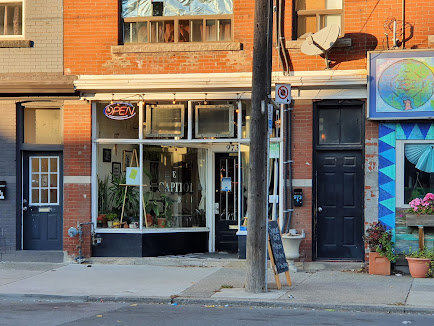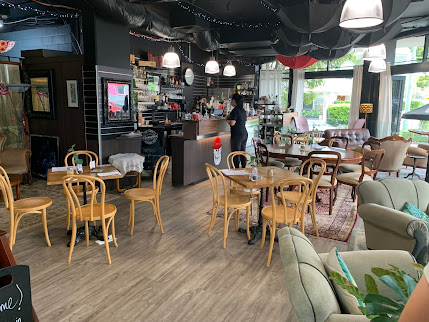 |
| Places like the Capitol Bar in Hamilton, Canada, create a shared dining space and opportunities for live music and conversation |
by Tarah Hodgkinson
We have written extensively on this blog, and elsewhere about the importance of the “third place”. In Ray Oldenburg’s work The Great Good Place, Oldenburg discusses the importance of the third place: Third places are spaces other than home (first place) and work (second place) where folks can meet, gather, connect and build social cohesion. He names several types of third places including cafes, hair salons, barbershops, pubs, libraries, bookshops and more that are at the heart of any great community. These are spaces that people can spend lots of unstructured time in without having to spend much money.
 |
| The Red Bowler cafe in the west end of Brisbane, Australia, holds seating for dining and comfy couches and eclectic decor for evening events |
In the wake of COVID-19 many of these local places are starting to disappear. Unable to keep up with the rising costs of rolling lockdowns and having to restrict the number of patrons, many of these establishments have either limited the time you can spend in them or been shuttered altogether. This has led to several issues including vacant storefronts, reducing foot traffic and eyes on the street, and increasing monopolies of these spaces by large corporations that are less interested in creating a space for their neighbours and building community cohesion.
We know that social cohesion relies on third places to bring together people together. We also know that a lack of these places, can reduce social cohesion and increase risks of crime. Never has that been a more prominent issue, than during a pandemic when we are literally more separated than ever before.
 |
| "Third places" draw people together for more than food and dining - they are gathering places, relaxing spaces, and conversation bases |
However, there are some shining rays of hope in neighbourhoods around the globe. In Brisbane, Australia for example, a small café called the Red Bowler, feels exactly like a third place. Here, the café is not only a place to grab a coffee and a bite to eat, but the staff also know the locals, regulars sit down at comfy couches near you to strike up a conversation and the owners hold weekly events including movie nights, live music, and even mobile dog washes. No one is rushed out and as a result, the community builds.
This is just one example of a commitment to create places that are neutral, inclusive and a home away from home. As we continue to emerge from the seemingly endless impact of COVID-19 on our everyday lives, it is more important than ever that we revive and support these third places. They are the neighbourhood cornerstones of connection that will help us to not only recover but thrive again as communities.
Leave a comment
Please add comments to SafeGrowth. I will post everyone except posts with abusive, off-topic, or offensive language; any discriminatory, racist, sexist or homophopic slurs; thread spamming; or ad hominem attacks.
If your comment does not appear in a day due to blogspot problems send it to safegrowth.office@gmail.com and we'll post direct.